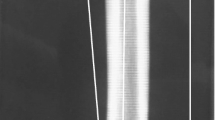Summary
The present study was undertaken to determine whether there is a constant difference between the angle of inclination and the Alsberg angle and to evaluate statistical relationships between the inclination angle, Alsberg angle and the angle between the anatomical and mechanical axes of the femur. Measurements were taken from 50 male femurs (25 right and 25 left, aged 30–40 years) from the Anatomy Department, Çukurova University: inclination angle was determined between the neck and the shaft of the femur; Alsberg angle, between a line drawn through the base of the epiphyseal plate and shaft of the femur; and the angle between the anatomical and mechanical axes. The results showed that, for the right and left femurs respectively, the average inclination angle was 123.72° and 125.96°; the angle between the anatomical and mechanical axes was 6.24° and 5.96°; and the average Alsberg angle was 39.92° and 40.61°. The difference between the angle of inclination and the Alsberg angle in this study was 83.80° and 85.36° for the right and left femurs respectively.
The correlation coefficient between the angle of inclination and Alsberg angle was 0.96 and 0.93 for the right and left femurs respectively, while those between the angle between the anatomical and mechanical axes and inclination angle were −0.89 and −0.91 for the right and left femurs respectively. Furthermore, the correlation coefficient between the angle between the anatomical and mechanical axes and Alsberg angle were −0.88 and −0.90 for the right and left femurs respectively.
Résumé
Cette étude a été réalisée pour vérifier qu’il y a une différence constante entre l’angle d’inclinaison et l’angle d’Alsberg et pour évaluer les relations entre l’angle d’inclinaison, l’angle d’Alsberg et l’angle formé par l’axe anatomique et l’axe mécanique du fémur. Les mesures ont été obtenues à partir de 50 fémurs masculins (25 droits et 25 gauches, chez des sujets âgés de 30 à 40 ans) du département d’Anatomie de l’Université Çukurova: l’angle d’inclinaison est mesuré entre le col du fémur et la diaphyse fémorale; l’angle d’Alsberg est formé par une ligne tracée au niveau de la base de la tête fémorale et l’axe de la diaphyse fémorale. Les résultats montrent que, respectivement pour le fémur droit et le fémur gauche, la moyenne de l’angle d’inclinaison était 123,72° et 125,96°; l’angle entre l’axe anatomique et l’axe mécanique était de 6,24° et 5,96° et la moyenne de l’angle d’Alsberg était de 39,92° et 40,61°. La différence entre l’angle d’inclinaison et l’angle d’Alsberg dans cette étude était de 83,80° et 85,36°, respectivement pour le fémur droit et le fémur gauche. Le coefficient de corrélation entre l’angle d’inclinaison et l’angle d’Alsberg est de 0,96 et 0,93 respectivement pour le fémur droit et le fémur gauche, alors qu’entre l’angle formé par l’axe anatomique et l’axe mécanique d’une part et d’autre part l’angle d’inclinaison, le coefficient de corrélation était de 0,89 et 0,91 respectivement pour le fémur droit et le fémur gauche. Par ailleurs, le coefficient de corrélation entre l’angle formé par l’axe anatomique et l’axe mécanique et l’angle d’Aslberg était de 0,88 et 0,90 respectivement pour le fémur droit et le fémur gauche.
Similar content being viewed by others
References
Backman S (1957) The proximal end of the femur. Acta Radiol 2 [Suppl]: 146
Ellis H (1992) Clinical Anatomy. 8th edn. Blackwell, London, p 235
Fabry G, Mac Ewen GD, Shans AR (1973) Torsion of the femur. A follow-up study in normal and abnormal conditions. J Bone Joint Surg [Am] 55-A: 381–385
Gardner E. Gray DJ. O’Rahilly R (1967) Anatomy, 2nd edn. Saunders, London, p 235
Kahle W, Leonhardt H, Platzer W (1986) Color atlas and textbook of human, 3rd edn. Thieme, New York, p 192
Moore KL (1985) Clinically oriented anatomy, 2nd edn. Williams & Wilkins, London. p 405
Roye DP. Chorney GS, Deutsch LE. Mahon JH (1990) Femoral varus and acetabular osteotomies in cerebral palsy. Orthopedics 13: 1239–1243
Rydell N (1973) Biomechanics of the hip joint. Clin Orthop 92: 6–15
Steindler A (1973) Kinesiology of the human body, 4th edn. Thomas, Florida, pp 267, 297–298
Williams PL, Warwick R, Dyson M, Bannister LH (1985) Gray’s Anatomy. 37th edn. Churchill Livingstone, Edinburgh, p 434
Author information
Authors and Affiliations
Rights and permissions
About this article
Cite this article
Oguz, Ö. Measurement and relationship of the inclination angle, Alsberg angle and the angle between the anatomical and mechanical axes of the femur in males. Surg Radiol Anat 18, 29–31 (1996). https://doi.org/10.1007/BF03207758
Received:
Accepted:
Issue Date:
DOI: https://doi.org/10.1007/BF03207758




